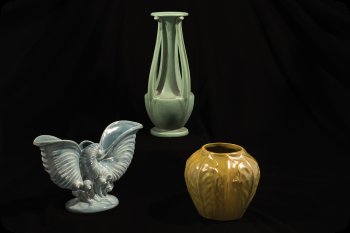Illinois Art Pottery
Illinois’ tradition of art pottery can be traced back to the Great Chicago Fire of 1871. In the wake of this tragedy, the need for economical, fireproof building materials was made clear, and the architectural terra cotta industry was born. At the same time, the Arts and Crafts movement inspired ceramists to combine artistry with industry to create pottery whose beauty lay not in hand-applied surface decoration but in innovative shapes.
The American Terra Cotta and Ceramic Company became the country’s first manufacturer of architectural terra cotta in 1889. The company’s founder, William Day Gates, experimented with the factory’s clays and glazes to create a line of art pottery he dubbed Teco (TErra COtta) that ultimately included more than 500 shapes, many of which were designed by Prairie School architects.
The Chicago Crucible Company was an art pottery founded 1917 and soon after taken over by the Northwestern Terra Cotta Company, which had been producing architectural tiles and trim since 1878. Chicago Crucible pottery continued to be produced until about 1932; the Northwestern Terra Cotta Company remained in business until 1965.
Haeger Potteries began as the Dundee Brickyard along the Fox River in 1852. German immigrant David Haeger became part owner of the company in 1871, the same year as the Chicago fire, and soon expanded the business to include tiles. In 1914, the company began making affordable art pottery. Royal Hickman was the chief designer from 1938-1944, and under his tenure, Haeger pottery grew more prestigious and desirable. The company was in business until 2016.





